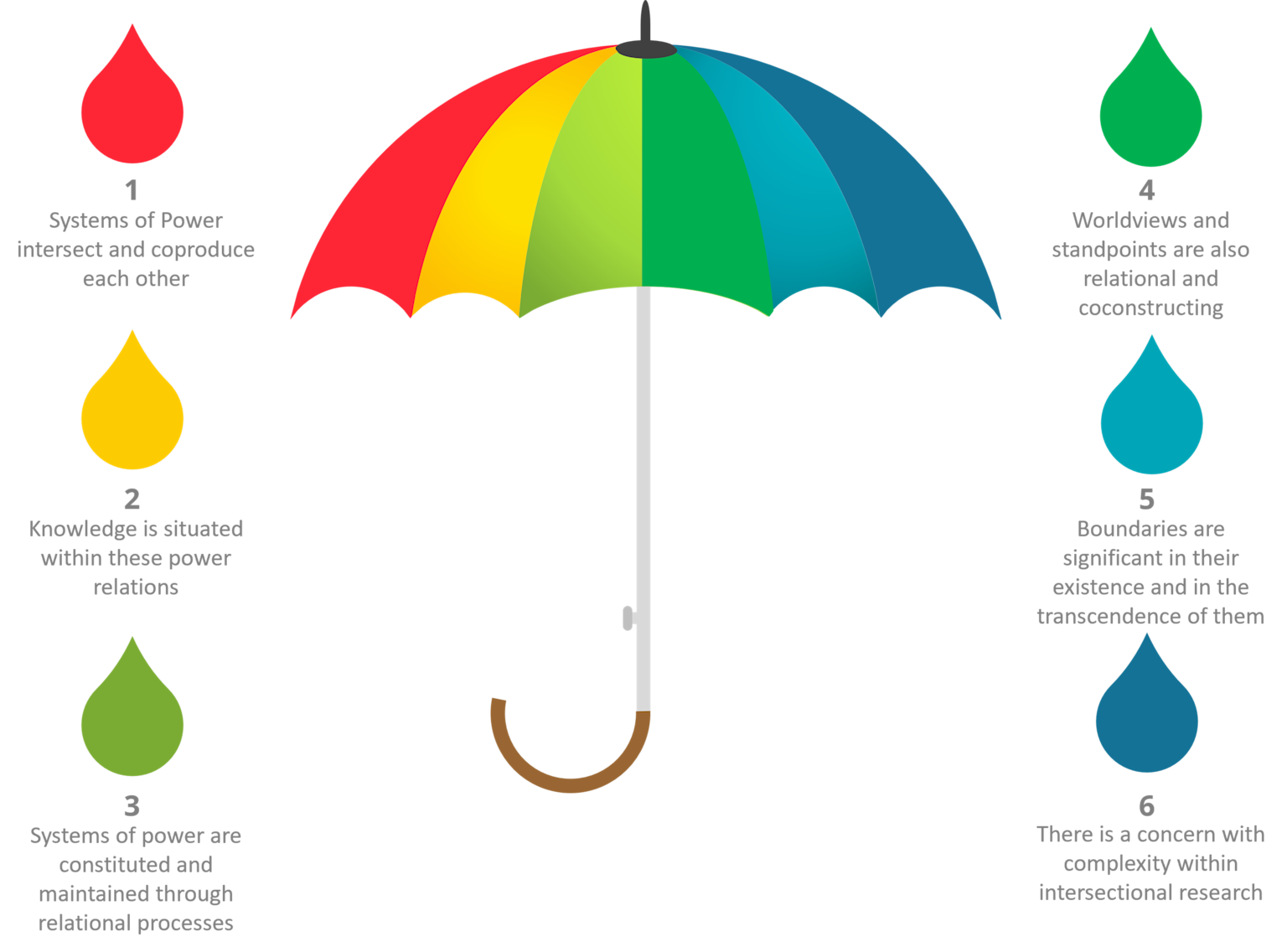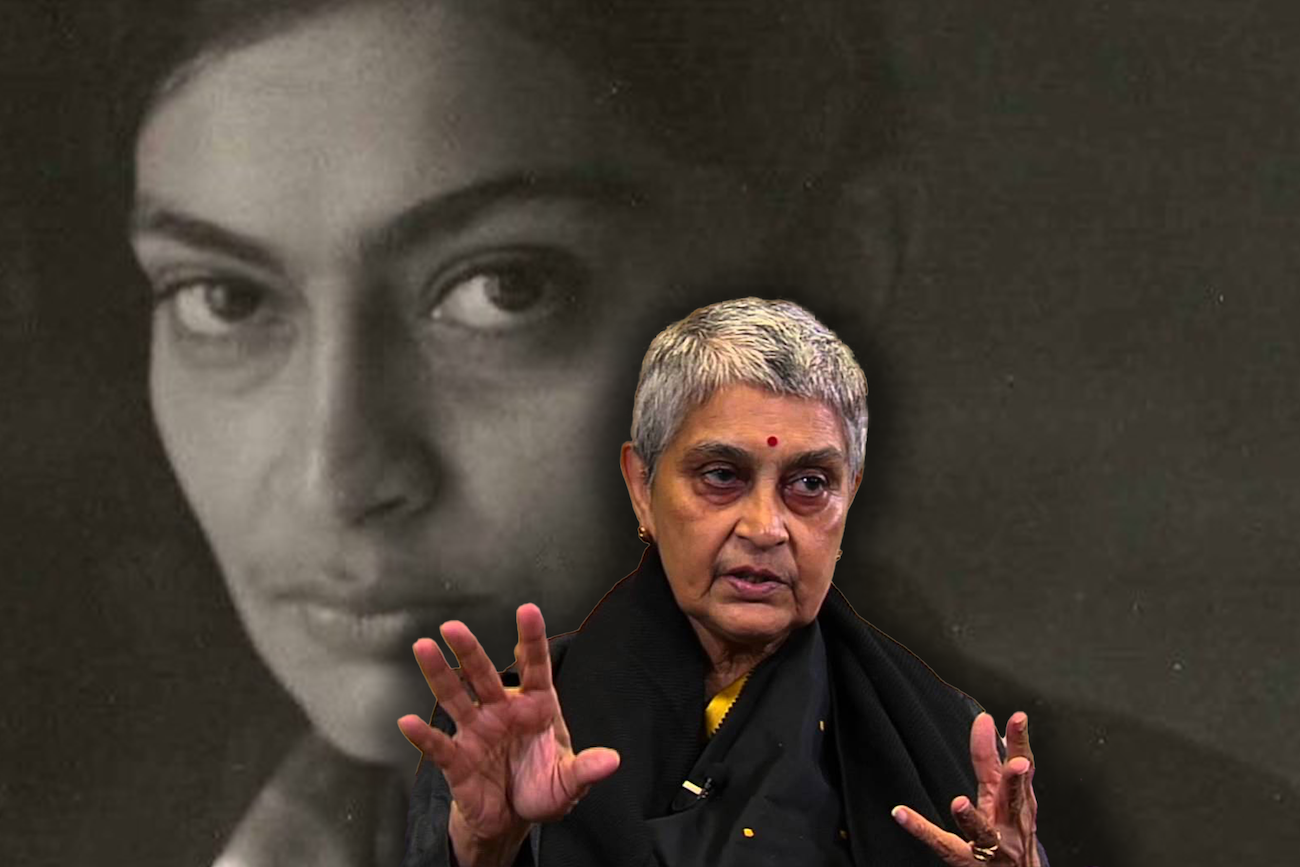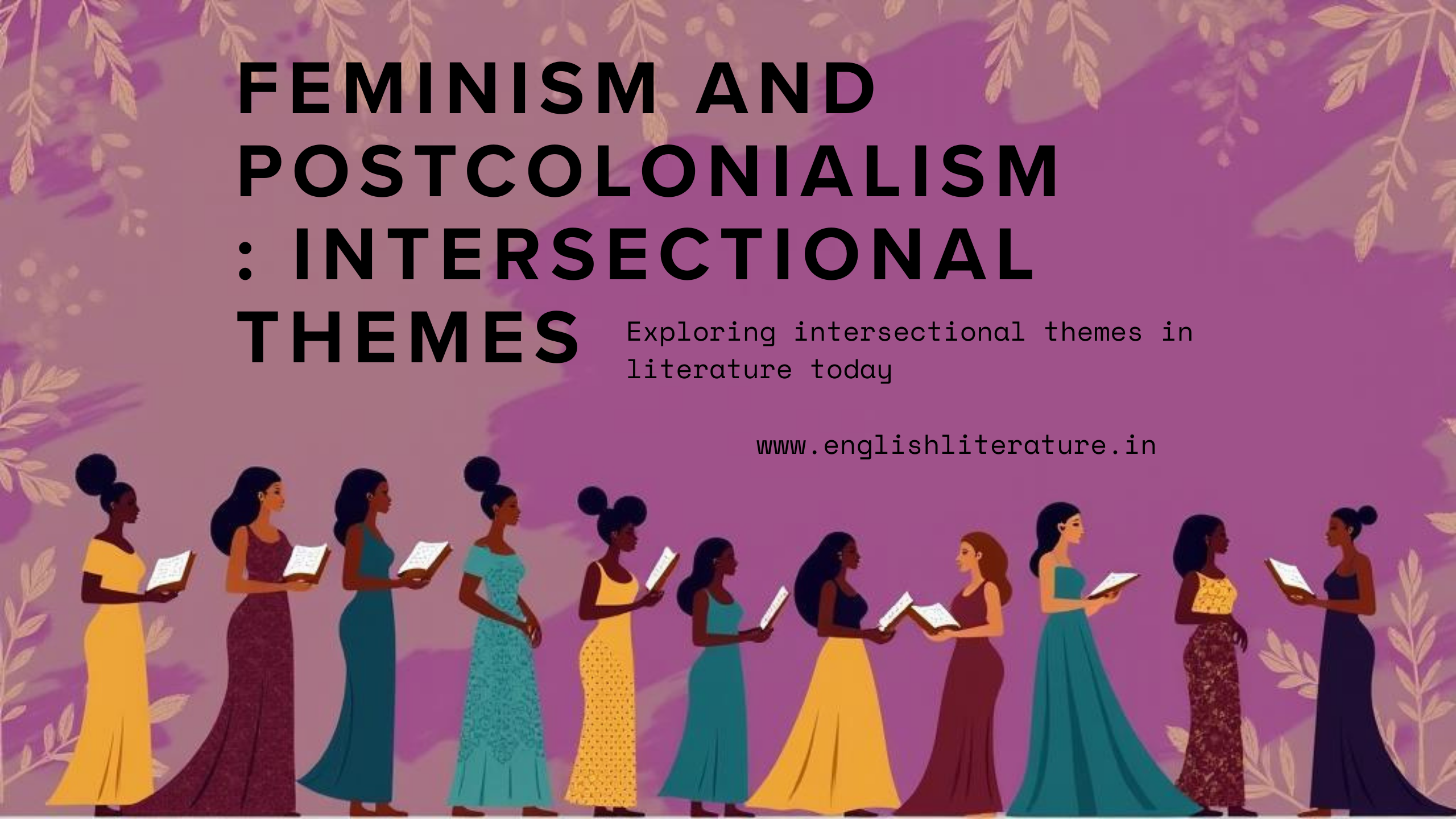Feminism and Postcolonialism: Intersectional Themes in English Literature
The intersection of feminism and postcolonialism represents one of the most dynamic and transformative movements in contemporary literary criticism. This convergence has fundamentally reshaped our understanding of literature, identity, and power structures, revealing how gender, race, class, and colonial history intertwine to create complex systems of oppression and resistance. As we navigate an increasingly interconnected world, the insights offered by postcolonial feminist literary criticism become ever more crucial for understanding both historical texts and contemporary global narratives.

Diagram illustrating the six key aspects of intersectionality theory using an umbrella metaphor belonging.hypotheses
Historical Context and Theoretical Foundations
The Emergence of Postcolonial Feminism
Postcolonial feminism emerged in the 1980s as a critical response to the perceived limitations of both traditional feminist theory and postcolonial studies. Western feminism, while groundbreaking in its challenges to patriarchal structures, had largely focused on the experiences of white, middle-class women, often marginalizing the voices and experiences of women of color and those from formerly colonized nations. Similarly, early postcolonial theory, though revolutionary in its critique of imperial power structures, frequently overlooked the specific ways in which colonialism affected women differently than men.
This gap gave birth to what scholars term “double colonization”—a concept first articulated by Kirsten Holst Petersen and Anna Rutherford in the 1980s. Double colonization refers to the dual oppression experienced by women in postcolonial societies: they face subjugation both as colonial subjects under imperial rule and as women within patriarchal systems. As Edward Said’s orientalist framework demonstrates, colonized peoples were positioned as “other” to the Western “self,” but women experienced an additional layer of othering within their own societies.
Intersectionality: A Revolutionary Framework
Central to understanding postcolonial feminism is the concept of intersectionality, coined by legal scholar Kimberlé Crenshaw in 1989. Crenshaw’s groundbreaking work revealed how race, gender, and class intersect to create unique experiences of discrimination that cannot be understood by examining these categories in isolation. Her foundational essay “Demarginalizing the Intersection of Race and Sex” demonstrated how Black women’s experiences were rendered invisible in both feminist and anti-racist discourse, as each movement treated identity categories as mutually exclusive rather than intersecting.

Gayatri Chakravorty Spivak, prominent feminist and postcolonial theorist, speaking at an academic event americankahani
Intersectionality has since evolved beyond its original framework to encompass a wide spectrum of social classifications, including socioeconomic class, sexual orientation, age, physical or intellectual disabilities, and other dimensions of individual identity. This expansion has proven particularly valuable for postcolonial feminist literary criticism, allowing scholars to analyze how multiple forms of oppression operate simultaneously in literary texts.
Key Theorists and Foundational Texts
Gayatri Chakravorty Spivak: The Subaltern Voice
Perhaps no figure looms larger in postcolonial feminist theory than Gayatri Chakravorty Spivak. Her seminal 1988 essay “Can the Subaltern Speak?” fundamentally challenged assumptions about agency, voice, and representation in postcolonial discourse. Through her analysis of the story of Bhuvaneswari Bhaduri, a young woman who committed suicide in colonial India, Spivak revealed how subaltern women—those occupying the lowest positions in social hierarchies—are systematically silenced by both colonial and patriarchal structures.
Spivak’s concept of “epistemic violence” describes how colonial discourse not only physically dominated colonized peoples but also destroyed their ways of knowing and understanding the world. For women, this violence was particularly acute, as they were silenced not only by colonial authorities but also by indigenous patriarchal structures that positioned them as subjects to be spoken for rather than agents capable of speech.
The Power of Intersectional Analysis
The theoretical framework of intersectionality has been crucial in analyzing how gender, race, and class interact in postcolonial contexts. As contemporary scholarship demonstrates, intersectional analysis reveals the “multiplicative effects” of oppression rather than mere additive ones. This means that a Black woman’s experience under colonialism cannot be understood simply as the sum of racial oppression plus gender oppression; rather, these categories interact to create entirely new forms of subjugation and, crucially, new possibilities for resistance.
Literary Techniques and Narrative Strategies
Reclaiming Voice Through Innovation
Postcolonial feminist writers have developed sophisticated literary techniques to challenge dominant narratives and create space for marginalized voices. These include:
Polyphonic Narratives: Many writers employ multiple narrators to represent diverse perspectives and challenge the authority of single-voice colonial narratives. This technique allows for the inclusion of voices that have been historically silenced or marginalized.
Magical Realism: Writers like Arundhati Roy use magical realism to blur the boundaries between rational Western discourse and indigenous ways of knowing. This technique becomes a form of epistemological resistance, challenging colonial definitions of reality and truth.
Fragmented Temporality: Non-linear narrative structures reflect the fragmented nature of postcolonial identity and challenge Western concepts of linear progress and development.
Linguistic Hybridity: The strategic mixing of languages, dialects, and cultural references creates what Homi K. Bhabha terms “hybrid” spaces that neither fully embrace nor reject colonial culture.

Cover image of ‘Wide Sargasso Sea,’ a seminal postcolonial feminist novel by Jean Rhys thedialoguebox
Canonical Works and Contemporary Voices
Jean Rhys: Wide Sargasso Sea
Jean Rhys’s “Wide Sargasso Sea” (1966) stands as a masterpiece of postcolonial feminist literature. This novel serves as a prequel to Charlotte Brontë’s “Jane Eyre,” telling the story of Bertha Mason—reimagined as Antoinette Cosway—before she becomes the “madwoman in the attic”. Rhys’s work demonstrates how colonial violence shapes women’s identities and reveals the racist and sexist assumptions underlying classic Victorian literature.
The novel illustrates the concept of cultural hybridity through Antoinette’s position as a white Creole woman who belongs neither fully to the colonizer nor the colonized community. Her eventual descent into madness can be read not as personal pathology but as the result of systematic colonial and patriarchal oppression.
Contemporary Voices: Adichie and Morrison
Chimamanda Ngozi Adichie represents a new generation of postcolonial feminist writers who have gained global recognition for their intersectional approach to storytelling. Her novels “Purple Hibiscus” and “Half of a Yellow Sun” explore how political conflict, religious authority, and gender expectations intersect in postcolonial Nigeria.

Cover of Chimimanda Ngozi Adichie’s novel Purple Hibiscus, a significant work in postcolonial feminist literature abstractaf
Toni Morrison, the first Black woman to win the Nobel Prize in Literature, brought African American women’s experiences to the forefront of world literature. Her novels, including “Beloved” and “The Color Purple,” demonstrate how trauma, memory, and healing intersect in the African American experience, revealing connections between slavery and ongoing forms of colonial violence.
Alice Walker and Womanism
Alice Walker’s contributions to postcolonial feminism extend beyond her literary works to include the theoretical framework of “womanism”. Walker’s concept of womanism emerged from her recognition that traditional feminism often failed to address the specific experiences of Black women, particularly their relationships with Black men and their communities. Her novel “The Color Purple” traces the journey of Celie, demonstrating how economic independence, sexual autonomy, and spiritual growth can serve as forms of resistance to both patriarchal and racist oppression.
The Role of Resistance and Agency
Beyond Victimization Narratives
One of the most significant contributions of postcolonial feminist criticism has been its refusal to portray women simply as passive victims of colonial and patriarchal oppression. Instead, these works reveal complex forms of resistance and agency that operate even within systems of domination.
Strategic Essentialism: Spivak’s concept of strategic essentialism describes how marginalized groups may temporarily embrace essentialist identities as a form of political strategy. This allows women to organize around shared experiences while recognizing the constructed nature of identity categories.
Everyday Resistance: Postcolonial feminist literature reveals how domestic spaces, religious practices, and cultural traditions can serve as sites of resistance to colonial and patriarchal authority.
Narrative Subversion: Writers employ techniques like unreliable narrators, metafiction, and intertextuality to challenge the authority of dominant discourses and create alternative ways of understanding history and identity.
Contemporary Developments and Global Perspectives
Decolonizing Feminist Theory
Recent scholarship has emphasized the need to decolonize feminist theory itself, moving beyond the incorporation of diverse voices to fundamentally restructuring how we understand gender, power, and resistance. This involves questioning the universality of Western feminist concepts and developing new theoretical frameworks grounded in non-Western epistemologies.
Transnational Feminism has emerged as a crucial framework for understanding how globalization creates new forms of both oppression and solidarity among women worldwide. This approach recognizes that colonialism’s effects persist in contemporary forms of economic, cultural, and political domination.
Indigenous and Decolonial Feminisms
Contemporary postcolonial feminist criticism increasingly incorporates Indigenous feminist perspectives and decolonial methodologies. These approaches challenge not only colonial structures but also the settler-colonial logic that continues to shape contemporary societies.
The concept of “decolonial feminism” goes beyond postcolonialism to imagine entirely new ways of organizing society based on Indigenous values of reciprocity, relationality, and respect for the natural world.
Impact on Contemporary Literary Studies
Pedagogical Transformations
Postcolonial feminist theory has transformed how literature is taught and studied in academic institutions. Curriculum diversification has led to the inclusion of works by women writers from formerly colonized nations, while new analytical frameworks help students understand how identity categories intersect in complex ways.
The integration of digital humanities and global perspectives has created new opportunities for comparative analysis across cultures and languages, allowing for more nuanced understandings of how colonial histories shape contemporary literary production.
Publishing and Canon Formation
The influence of postcolonial feminist criticism has been instrumental in reshaping literary canons and publishing practices. Major publishing houses now actively seek out works by women writers from the Global South, while literary prizes increasingly recognize the importance of diverse voices.
However, critics note that this inclusion sometimes operates within existing power structures rather than fundamentally challenging them, leading to concerns about tokenism and cultural appropriation.
Challenges and Future Directions
Theoretical Limitations
Despite its significant contributions, postcolonial feminist criticism faces several ongoing challenges. The institutional location of much postcolonial feminist scholarship in Western universities raises questions about who controls these narratives and how they are interpreted.
Additionally, the expansion of intersectionality beyond its original framework has led to debates about whether the concept has been diluted or co-opted by institutional structures that it was originally designed to challenge.
Global Digital Age Considerations
As we move further into the digital age, new questions emerge about how technology, globalization, and virtual spaces affect the experiences of women in postcolonial contexts. Contemporary writers are exploring how social media, migration, and climate change create new forms of both oppression and connection among women worldwide.

Portrait of Chimamanda Ngozi Adichie, a leading feminist and postcolonial author, showcasing her distinctive hairstyle opencountrymag
The rise of #MeToo movements in various cultural contexts has revealed both the universality of certain forms of gender-based violence and the ways in which local cultural, political, and economic factors shape women’s experiences differently across the globe.
Critical Applications: Audre Lorde and “The Master’s Tools”
Audre Lorde’s influential essay “The Master’s Tools Will Never Dismantle the Master’s House” provides a crucial framework for understanding the relationship between postcolonial feminism and institutional power. Lorde’s critique of white feminism’s tendency to replicate exclusionary practices offers important insights for contemporary postcolonial feminist practice.
Lorde’s concept of difference as a source of strength rather than division aligns with intersectional approaches to literature that celebrate the complexity of identity rather than seeking to reduce it to single categories. Her emphasis on the importance of marginalized women supporting each other across differences provides a model for the kind of solidarity that postcolonial feminist criticism seeks to foster.
Contemporary Relevance and Global Applications
Climate Change and Environmental Justice
Recent scholarship has explored connections between postcolonial feminism and environmental justice, recognizing that climate change disproportionately affects women in the Global South. Writers like Arundhati Roy have increasingly focused on how environmental degradation and corporate exploitation represent contemporary forms of colonial violence.
Ecofeminism provides a framework for understanding how the domination of women and the exploitation of nature are interconnected phenomena rooted in similar ideological structures. This perspective has become increasingly relevant as climate change and environmental destruction accelerate.
Migration and Displacement
Contemporary postcolonial feminist writers are increasingly addressing issues of migration, displacement, and refugee experiences. These works explore how globalization creates new forms of both opportunity and vulnerability for women, particularly those from the Global South who migrate to work in domestic, care, and service industries in the Global North.
The concept of “transnational care chains” reveals how global economic structures depend on the extraction of care labor from women in the Global South, creating new forms of colonial relationship disguised as economic opportunity.
FAQ Section
1. What is the difference between feminism and postcolonial feminism?
While traditional feminism focuses primarily on gender-based oppression, postcolonial feminism examines how gender intersects with race, class, colonialism, and cultural identity. It specifically addresses the experiences of women from formerly colonized nations and challenges the universalist assumptions of Western feminist theory.
2. How does intersectionality apply to literary analysis?
Intersectionality in literary analysis involves examining how multiple identity categories (race, gender, class, sexuality, etc.) work together to shape characters’ experiences and narrative structures. Rather than analyzing these categories separately, intersectional analysis reveals how they interact to create unique forms of oppression and resistance.
3. What is “double colonization” and how does it appear in literature?
Double colonization refers to the dual oppression experienced by women in colonized societies—they face subjugation both as colonial subjects and as women within patriarchal systems. In literature, this appears through characters who must navigate both colonial authority and indigenous patriarchal structures.
4. Who are some key authors in postcolonial feminist literature?
Key authors include Gayatri Spivak, Jean Rhys, Toni Morrison, Alice Walker, Chimamanda Ngozi Adichie, Arundhati Roy, Tsitsi Dangarembga, and Nawal El Saadawi. Each brings unique cultural perspectives and theoretical insights to the intersection of gender, race, and colonial history.
5. How has postcolonial feminist criticism changed literary studies?
It has diversified curricula to include more works by women writers from the Global South, developed new analytical frameworks for understanding identity and power, and challenged traditional literary canons. It has also influenced publishing practices and prize committees to recognize diverse voices.
6. What literary techniques do postcolonial feminist writers commonly use?
Common techniques include polyphonic narratives, magical realism, fragmented temporality, linguistic hybridity, unreliable narrators, and metafiction. These strategies challenge dominant narrative forms and create space for marginalized voices.
7. How does contemporary postcolonial feminism address globalization?
Contemporary postcolonial feminism examines how globalization creates new forms of both oppression and solidarity. It analyzes issues like transnational migration, environmental justice, digital technology, and global economic structures that continue to replicate colonial relationships.
8. What is the relationship between postcolonial feminism and environmental justice?
Recent scholarship explores how environmental degradation disproportionately affects women in the Global South, connecting ecological destruction to colonial and patriarchal domination. Ecofeminism provides frameworks for understanding these interconnections.
9. How do contemporary writers continue postcolonial feminist traditions?
Contemporary writers like Chimamanda Ngozi Adichie build on earlier traditions while addressing current issues like digital technology, climate change, migration, and global economic inequality. They continue to challenge dominant narratives while creating new forms of literary expression.
Postcolonial feminist literary criticism continues to evolve as a vital framework for understanding literature in our interconnected world. By revealing the complex intersections of gender, race, class, and colonial history, this approach offers crucial insights into both historical and contemporary texts. As we face ongoing challenges related to globalization, climate change, and persistent inequalities, the intersectional lens provided by postcolonial feminist criticism becomes increasingly essential for creating more just and inclusive literary and social landscapes. Through the continued work of scholars, writers, and activists worldwide, this tradition promises to keep generating new insights and fostering greater understanding across cultural and geographical boundaries.
This blog post is part of our ongoing exploration of contemporary literary criticism at www.englishliterature.in. For more in-depth analysis of feminist and postcolonial themes in literature, explore our extensive archive of critical essays and author studies.
25 Weird Words Writers Secretly Love (With Hindi Meaning and Sentences)


I have been surfing on-line more than 3 hours as of late, but I never discovered any interesting article like yours. It’s lovely value sufficient for me. In my opinion, if all webmasters and bloggers made just right content material as you probably did, the internet might be a lot more helpful than ever before.